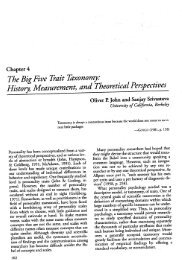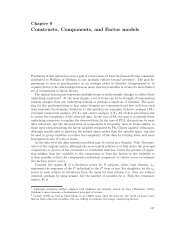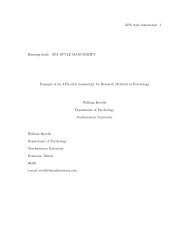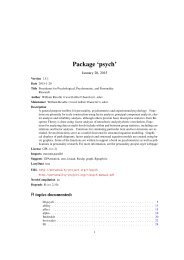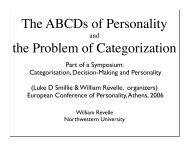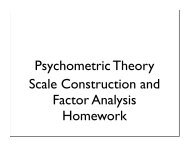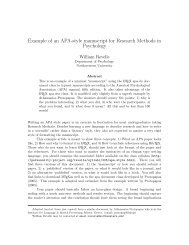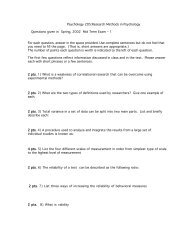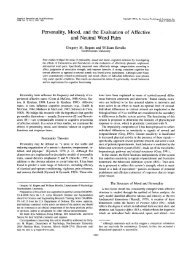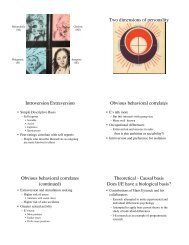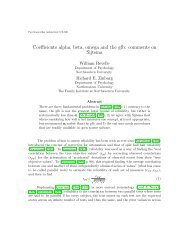Choleric (NE) - The Personality Project
Choleric (NE) - The Personality Project
Choleric (NE) - The Personality Project
You also want an ePaper? Increase the reach of your titles
YUMPU automatically turns print PDFs into web optimized ePapers that Google loves.
Melancholic(NI)<strong>Choleric</strong>(<strong>NE</strong>)Phlegmatic(SI)Sanguine(SE)
Two dimensions of personality
Introversion Extraversion• Simple Descriptive Basis– Self reports• Sociable• Active• Impulsive• Spontaneous• Peer ratings correlate with self reports– People who describe themselves as outgoingare more known to others
Defining items from IPIP•Am skilled in handling social situations.•Am the life of the party.•Don't mind being the center of attention.•Know how to captivate people.•Start conversations.•Feel comfortable around people.•Make friends easily.•Cheer people up.•Warm up quickly to others.•Talk to a lot of different people at parties.•Don't talk a lot.•Retreat from others.•Am hard to get to know.•Avoid contacts with others.•Don't like to draw attention to myself.•Have little to say.•Keep in the background.•Find it difficult to approach others.•Would describe my experiences as somewhat dull.•Keep others at a distance.4
Obvious behavioral correlates• E’s talk more– But this interacts with group size– More well known• Occupational differences– Extraversion and success in sales (but is this ambition or sociability?)• Introversion and preference for isolation
Obvious behavioral correlates(continued)• Extraversion and stimulation seeking– Higher risk of arrest• (interacts with social class)– Higher risk of auto accidents• Greater sexual activity– E’s have• More partners• Earlier onset• Prefer more positions
<strong>The</strong>oretical - Causal basisDoes I/E have a biological basis?• Contributions of Hans Eysenck and hiscollaborators as an example of programmaticresearch in personality– Eysenck attempted to unite experimental and individualdifferences psychology– Attempted to apply best current theory to the study ofindividual differences– I-E research as an example of programmatic research• More recent work on I/E has not been as programmatic
I-E Early work• Differences in conditionability– Original hypothesis• Introverts are easily conditioned• Introverts become well socialized– Later findings• Conditioning differences depend upon situation• Low arousal situations lead to better conditioningfor introverts• Impulsivity more important than extraversion(Levy and Eysenck, 1972)
I-E and conditioning• Newman’s work on psychopaths and conditioning– ability to stop• Gray’s model of anxiety, impulsivity andconditioning (reinforcement sensitivity)• Zinbarg– Sensitivity to cues of reward and action (impulsivity)– Sensitivity to cues of punishment and inaction(anxiety)• Gray’s revised model of Reinforcement Sensitivity <strong>The</strong>ory– Gray and McNaughton (2000); Corr (in press)
AnxiousGray’s original hypothesisNeuroticImpulsiveIntrovertsExtravertsNon-impulsiveSensitivity for Cues for RewardStableNon-anxiousSensitivity for Cues for Punishment
Hypothesis of arousal differences• What is arousal?– Arousal of the hand, the heart, and the head• Skin conductance• Heart rate• EEG desynchronization– Self reports (Robert Thayer, Gerry Matthews)• Energetic arousal• Tense arousal
1.02 Dimensions of AffectDISTRESSEDFRUSTRATEDSAD TENSE0.5IRRITABLEANXIOUS0.0TIREDSLEEPYINACTIVEEXCITEDELATEDE<strong>NE</strong>RGETIC LIVELYENTHUSIASTICATTENTIVE-0.5AT_RESTCALMRELAXED-1.0 -0.5 0.0 0.5 1.0
Representative MSQ items(arranged by angular location)Item EA-PA TA-NA Angleenergetic 0.8 0.0 1elated 0.7 0.0 2excited 0.8 0.1 6anxious 0.2 0.6 70tense 0.1 0.7 85distressed 0.0 0.8 93frustrated -0.1 0.8 98sad -0.1 0.7 101irritable -0.3 0.6 114sleepy -0.5 0.1 164tired -0.5 0.2 164inactive -0.5 0.0 177calm 0.2 -0.4 298relaxed 0.4 -0.5 307at ease 0.4 -0.5 312attentive 0.7 0.0 357enthusiastic 0.8 0.0 358lively 0.9 0.0 360
Basal arousal differences• Detected in psychophysiologicalexperiments– (see Stelmack, 1990 for a review)– Electrophysiology (EEG)• Now you see it, now you don’t• Gale, 1981• Gale and Coles suggestion conditions need to bejust right
Basal arousal differences• Sedation threshold– Shagass (1955), Claridge et al. (1981)• Skin Conductance– Revelle (1973)– Wilson (1989)• Spontaneous GSR– Crider and Lunn (1971)• Photic Driving– Robinson (1982)
Sedation ThresholdC. Shagass (1955)
Threshold differences detected bypsychophysical methods• Light Sensitivity (threshold)– Siddle (1967) staircase method• Sound sensitivity– Smith (1968) forced choice• Pain sensitivity– Haslam (1967)– Petrie (1960)• Bi-modal sensitivity– Shigehisa and Symons (1973)• Reaction to lemon juice– Eysenck, 1967
Body temperature and time of day• Blake (1967) was cited as showingbiological differences related to arousal buthow relevant is this to basic theory?• Folkard (1976)• Eysenck and Folkard (1980)• Wilson (1990)
Body Temperature as f(time of day)(Baehr, Revelle & Eastman, 2000)90807038.0Sleep60504030Temperature (C°)37.0Temp.at bedLatest T MINS(N = 11)EastWestNorthT emp.at wake2010036.016:00 20:00 00:00 04:00 08:00 12:00 16:00Time (hours)1st Qtr 2nd Qtr 3rd Qtr 4th Qtr
Morningness/Eveningness and BT(Baehr, Revelle and Eastman, 2000)100Temperature (¡C)8060402003 7.53 7.03 6.5M-types3 6.016:00 20:00 00:00 4:00 8:00 12:00 16:001st Qtr 2nd Qtr Tim e 3rd (hoQtr urs) 4th QtrE-types= Average Sleep= Average T M I<strong>NE</strong>astWestNorth
Is it level, or rates of change?• Vigilance decrements from sleepdeprivation similar to that of extraverts• Do stimuli lose arousing properties fasterfor extraverts/high impulsives?• Habituation of orienting response• Bowyer, Humphreys and Revelle suggestedthat the effect was a decay rate in arousal• But Anderson and Revelle show interactionwith Time of Day
Behavioral Consequences ofarousal differences• Differences in Arousal preference– Wundt’s curvilinear hypotheses• Moderate levels of arousal are morepleasing than extreme levels• (“the Goldilocks hypothesis”)– Berlyne• Changes in arousal are more pleasing than asteady state• Increases or decreases are pleasant
Wundt’s hedonic curve(adapted from Berlyne)Hedonic tone ->BoringPleasantFrighteningArousal potential ->
Berlyne’s hedonic curve(adapted from Berlyne)CalmingExcitingHedonic tone ->BoringAdaptation toCurrent StateFrighteningArousal potential ->
Wundt’s hedonic curve +Individual Differences(adapted from Eysenck)PleasantHedonic tone ->IntrovertsBoringExtravertsFrighteningArousal potential of situation ->
Most preferred arousal level• Sound preference– Elliot– Hockey• Complexity preference– Bartol• Extraversion and the “three F’s syndrome”– Fags (cigarettes)– Fornication– Firewater
Logical problems with arousalpreferences hypothesis• What is arousing?– Mountain climbing? Chess playing? Small boatsailing?• What has subject done before coming tolaboratory– Extraverts being sociable– Introverts studying
Does <strong>Personality</strong> make a difference?• Important Life Criteria– Longevity (Friedman et al.)– Job Performance (Hunter and Schmidt)– Psychological well being• Laboratory tasks– Cognitive sensitivities and biases (eg.,McCloud, Mathews, Matthews, etc.)– Systematic pattern of results with cognitive performance by stressmanipulations (eg., Anderson, 1990; Anderson and Revelle, 1994; Revelle, Humphreys, Simon, Gilliland, 1980; Revelle, 1993)
I-E and performance differencesunder stress and boredom• Performance as a curvilinear function ofarousal and task difficulty– Yerkes and Dodson, 1908– Hebb (1955)– Broadhurst (1958)– Broadbent (1971)
Yerkes and Dodson, 1908Discrimination learning
Yerkes and DodsonLearning and shock level
Yerkes and Dodson, 1908
Yerkes and Dodson, 1908
Yerkes and Dodson curvein terms of arousal and task difficultyEasyPerformanceHardModerateArousal - >
Yerkes and Dodson revisited• Is it a lawful relationship?• Does performance in fact vary as stress/arousal• Is there a relationship with task difficulty• Continues to be controversial interpretation
Hebb Curve (1955)Optimal Level of Response and LearningLevel of “Cue Function”(or possibility thereof)DeepSleepIncreasing Interest,Alertness,Positive EmotionPoint of awakeningIncreasingEmotionalDisturbance,anxietyLevel of Arousal function (non specific cortical bombardment)
Eysenck and the Hebb Curve• Performance as curvilinear function ofarousal• Introverts more aroused than extraverts• <strong>The</strong>refore, introverts should do well underlow stress situations, extraverts in highstress situations
Eysenck + Hebb (1967)Optimal Level of Response and LearningLevel of “Cue Function”(or possibility thereof)DeepSleepIntrovertIncreasing Interest,Alertness,Positive EmotionPoint of awakeningIncreasingEmotionalDisturbance,anxietyExtravertLevel of Arousal function (non specific cortical bombardment)
Evidence in support of I-Eperformance hypothesis• No curvilinearity, but consistent– Frith (1967) detection of flicker fusion• Quiet versus noise• Extraverts versus introverts– Corcoran (1972) tracking performance• Sleep deprivation (12, 36, 60 hours)• Extraversion-introversion
Supporting Evidence• Curvilinear and consistent– Davies and Hockey (1966)• Detection task• Quiet versus noisy• Low versus high signal frequency• Extraverts versus introverts• (note that 2*2*2 design has many possiblecompatible results)
Supporting evidence• Gupta 1977: IQ tests– 0, 5, 10, 15 mg of amphetamine– Extraverts versus introverts– But later work from their lab was plagiarizedfrom Anderson leading one to question anyfindings from their lab
Feeble attempts at theory testing• Revelle, 1973– Performance on digit symbol, maze tracking, andanagrams (3 levels of difficulty for each task)– 6 stress levels• 1 person, relaxed• 2 person, relaxed• 2 person, competing• 2 person, competing for money• 8 person, competing for money• 8 person, competing for money, noise– Mixed results• What is arousing?
Introversion, time pressure, andcaffeine: effect on verbal performanceVerbal GRE Performance560Standardized for NU540Introverts520500Ambiverts480460ExtravertsRelaxed Timed CaffeineRevelle, Amaral, & Turriff, 1976 ScienceStress-->
Multiple attempts at replication• Multiple studies tried to replicate theoriginal Revelle, Amaral and Turiff results• Mixed results– Sometimes would see it– Sometimes would not• Eventually discovered the problem
Extraversion, Caffeine, and Cognitive PerformanceGilliland, 1976
Impulsivity, Caffeine, and Time of Day:the effect on complex cognitive performance0.4AM PerformanceCognitive Performance(median standardscores)0.20.0-0.2-0.4High ImpulsivesLow ImpulsivesPlaceboCaffeineRevelle, Humphreys, Simon and Gilliland, JEP:G, 1980
Impulsivity, Caffeine, and Time of Day:the effect on complex cognitive performance0.4AM PerformancePM PerformanceCognitive Performance(median standardscores)0.20.0-0.2-0.4High ImpulsivesLow ImpulsivesPlaceboCaffeinePlaceboCaffeineRevelle, Humphreys, Simon and Gilliland, JEP:G, 1980
Extraversion vs. Impulsivity• Caffeine effects were systematic, but not forextraversion, but rather for impulsivity• Systematic interaction with time of day• Implications– Performance does vary as function of personality andarousal, but depends upon time of day– <strong>Personality</strong> dimension of relevance was impulsivity
General reanalysis of previous I-Eeffects -- were they impulsivity• Relationship of impulsivity to extraversion– Old Eysenck scales were Impulsivity +Sociability– Newer scales (including Big 5 markers) aremore sociability and ambition• <strong>The</strong>ories of extraversion and arousal - werethey theories of impulsivity?
<strong>Personality</strong> and Cognition:early attempts at a synthesis• Humphreys and Revelle, 1984– <strong>Personality</strong> Traits x situational cues produce– Motivational States (arousal and on task effort)– Inverted U between arousal and performance isthe result of two processes• Arousal facilitates Sustained Information Transfer(SIT) and inhibits Working Memory• On task effort facilitates SIT
Simple stage model of processing-<strong>Personality</strong> effects at each stageConceptual Stages of Information ProcessingStimulusResponseStimulusDetectionandSelectionStimulusEncodingInformationIntegrationResponseSelectionandExecutionMemory of conditionalprobabilities of past eventsFeedback Loops
<strong>Personality</strong> affects each stage of processing• Introversion facilitates detection invigilance tasks• Anxiety facilitates detection of threat terms• Depression facilitates memory for negativeevents• Intelligence facilitates processing speed
Arousal and Performance(Hypothetical description of Yerkes and Dodson Effect)10.90.80.7Performance0.60.50.40.30.20.10Arousal0 1 2 3 4 5 6
Arousal and Working Memory10.90.80.7Working Memory0.60.50.40.30.20.10Arousal0 1 2 3 4 5 6
Arousal and Information Transfer10.9Sustained Information Transfer0.80.70.60.50.40.30.20.100 1 2 3 4 5 6Arousal
Arousal and Performance:Arousal, Working Memory andInformation Transfer10.90.8Cognitive Process0.70.60.50.40.30.20.10Arousal0 1 2 3 4 5 6
Humphreys and Revelle, Psychological Review, 1984
Yet another “plumbing diagram” relatingpersonality, affect, and cognition



